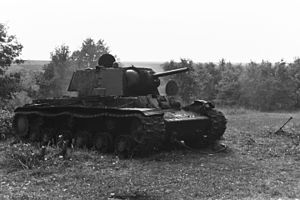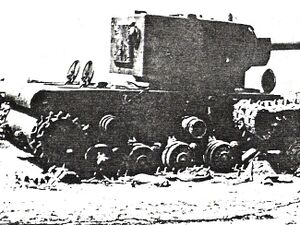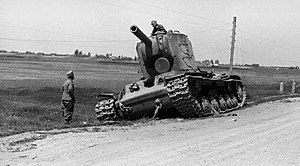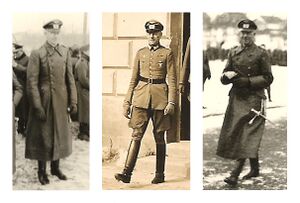1942/Mai/15/en: Unterschied zwischen den Versionen
| Zeile 4: | Zeile 4: | ||
| {{Geoo| [[w:uk:Маяцька_дача|Christishche Forest]] }} {{Geok|https://www.google.de/maps/place/Mayats%CA%B9ka+Dacha/@48.9456758,37.4094992,11z/}} | | {{Geoo| [[w:uk:Маяцька_дача|Christishche Forest]] }} {{Geok|https://www.google.de/maps/place/Mayats%CA%B9ka+Dacha/@48.9456758,37.4094992,11z/}} | ||
| | | | ||
| − | | temporarily [http://www.lexikon-der-wehrmacht.de/Gliederungen/Korps/LIIKorps.htm LII. A.K.]<ref> | + | | from 15 May noon temporarily [http://www.lexikon-der-wehrmacht.de/Gliederungen/Korps/LIIKorps.htm LII. A.K.]<ref>KTB 257. I.D., NARA T-315 Roll 1805 Frame 000998; the status report (Zustandsbericht) of 20 May was sent to XXXXIV. A.K. (Frame 001042)</ref> | CG: [http://www.lexikon-der-wehrmacht.de/Personenregister/O/OttEugen.htm Gen d Inf Ott] {{wpl|Eugen Ott (General der Infanterie)}} |
| | | | | | ||
| | | | | | ||
Version vom 18. Mai 2022, 11:15 Uhr
| GEO & MIL INFO | ||||
|---|---|---|---|---|
| Christishche Forest | ||||
| from 15 May noon temporarily LII. A.K.[1] | ||||
| CG: Gen d Inf Ott WP | ||||


It is a modified type of the KV I. There were only two types of this KV class (KV-1 in four variants and KV-2). They were dangerous, but too cumbersome, and were soon replaced by other models.
The third morning dawns, far too quickly for our frazzled nerves. Will they come today? Or maybe not at all? The night was quiet. Between hope and doubt, we head for the new day. And with the first rays of light of the new day, the cursed engines start up again. Lord, who can bear that. There they are already! Only thirty metres ahead of us stand these disgusting giant toads. There are four of them. Two of them are still standing in the forest, the other two have already advanced to the edge. Their rumps are still covered by bushes, but their barrels stretch out threateningly forward. The strongest of them is a 60-ton vehicle, a KV-1. Suddenly its engines roar wildly, it jolts and rolls forward. The arm-thick little trees snap and lay down in a fan shape in front of the colossus. It rolls on, flattening a bunker, and now stands in the middle of the courtyard. It is lonely and empty, but a hundred attentive and somewhat worried eyes follow it out of the slits in the hidden bunker positions. Our men are doing the right thing. We are powerless against this colossus. Our target is the infantry - if they come.
The steel giant is now slowly turning its tower. A flash - and a shell crashes into the ruins above our bunker. Smmash - a second one. But he can’t find a worthwhile target and stands there indecisive. In the meantime, the other three tanks have also rolled out of the forest and are slowly rattling into the wide yard. They are T-34.
Suddenly a couple of Landsers run back from one of the front bunkers. They must have feared being cut off. They had lost their nerve. This was also a signal for the others to retreat. Now no one wanted to stay behind. The will to resist was shaken. One group after the other retreated. Perhaps some of them thought they had been ordered to retreat and had not heard it. Be that as it may, these four men made a grave mistake. A dam had broken through them, and they swept a whole stream of men along with them. They came out of the bunkers, jumped behind the ruins and under the protection of these wall remains ran across a meadow to the next edge of the forest. Now we too had to retreat from the commander’s bunker with the rest of the men along the same path. At the edge of the forest, we took up our positions again. We had to leave the wounded in the medical bunker behind, because the KV-1 was right next to this earth bunker without knowing it. The brave paramedics had stayed with the wounded.
From the edge of the forest, from barely a hundred metres away, we watch the first Russian infantrymen enter the forester’s lodge. There are not many of them. Or do they still not dare to come out? The KV-1 had noticed our retreat and now rolls out of the courtyard in a wide arc around the ruins into the open field. The ruins had blocked its view. Now he has a clear field of fire across to us at the edge of the forest. He makes an effort to roll towards us.
But as he stands there in the open field, he comes into the field of fire of our 3.7-Pak, whose position was a little away from the forester’s lodge in the open field. A 3.7 against a KV‑1 ! that borders on suicide to want to fight a superheavy tank with this "army door-knocking device". Even more so as this Pak stands almost uncovered in an open field. Its only protection is the hollow in which the gun stands and from which it sticks out its thin little gun barrel. So this tiny Pak faces the behemoth like David faces the giant Goliath. But it shoots! These daredevils of tank hunters take up the unequal fight. They slam a grenade into the colossus’ turret, causing sparks to fly. Once more the Pak barks, but the projectile bounces off the steel turret like a pea and shoots straight up into the air as a glowing spark. Again the Pak bangs, and then the unbelievable happens: The giant stops, then even rolls back. He doesn’t shoot any more. We notice that he no longer moves his barrel. Probably a Pak grenade has hit and jammed the turret’s slewing ring. When the three other T-34s see their big brother wobbling back, they also crawl backwards into the forest. Our chief grasps the situation in a flash and suddenly rushes out of the forest with a "Hooray". I immediately follow second, because I was lying next to him, and roar out as well. Now the whole company breaks out of the forest in waves and runs across the meadow towards the forester’s lodge, shouting "Hooray" in many voices. The forest echoes with the battle cries of the company rushing forward. We shoot as we run, so that it pelts. By the time we reach the forester’s lodge, the T-34s and their accompanying infantry had already made it out the other side. One of the tanks had used a swathe as a way back. In doing so, it came into the field of fire of our third Pak, which had its position in the big barn. They shot its track and it broke down, crippled.
The KV-1 which had advanced furthest was also the last to retreat. This giant covered the retreat of the T-34s and the infantry. The first of us had already reached the ruins of the forester’s lodge when the KV-1 stuttered past us across the yard. It’s barely thirty metres away, and the commander is peeking his head out of the turret hatch. I fire a burst from my submachine gun. Then he quickly flips the lid shut. While the colossus disappears, Lieutenant Schröder jumps into the middle of the courtyard and, standing up, shoots freehand after the Russians. He is in my field of fire and I yell for him to move aside, but he does not. After the fight, a sergeant tells him that if he continues to be so foolhardy, he won’t grow old.[2]
We stop the banging. There is nothing left to fire at. The tension is releasing. I suddenly feel a foul smell in my nose. I sniff the air, look around me and realise that the cover I had thrown myself behind in the heat of battle was a pile of dried guts.
We had just retaken the forester’s lodge when a company led by a lieutenant arrived. It had been ordered to recapture the forester’s lodge in a counterattack and was most surprised to find us already back in it.[3]
The shot T-34 lay overnight on the forest road about a hundred metres away. Then a small assault squad led by Lieutenant Schröder crawled out. They wanted to try to blow the thing up, but came back empty-handed because the tank was too heavily guarded. Therefore, the Pak that had shot it yesterday tried to destroy it today during the day with a Panzerfaust grenade. The operator was firing this modified Panzerfaust for the first time and had no experience with it. The shot missed. But now the Ivan had recognised the Pak position and fired at it until the barn caught fire and burned down.
Those were three hot days. My first battle against tanks. It was hard and bloody. In those three days we lost 40 men dead and wounded. Now we are down to 80 men on the forester’s lodge. But new events will soon make us forget the losses. Besides, we are also a little proud. For three days the Soviets raided us again, but they didn’t even get through with tanks!
Our wounded can also breathe again. They had remained as quiet as mice in their hiding place underground while red tanks and infantry surged back and forth above them. They had not been noticed.
Three important experiences have been reconfirmed in this struggle:
1.) It is not always the weapons that decide victory, but manly courage, not superior weaponry, but the nerves and intrepidity of the fighter (the chief who immediately followed up when the KW-1 retreated).
2.) The Russian often attacks from spaces where he is not expected, believing the terrain to be unsuitable for an attack. (The tanks did not come down the swathes (where our Paks were) but right through the forest).
3.) Soldiers going back during combat (because often they are only messengers) sometimes creates critical moments. This must be taken more into account in training.
The Russian is unpredictable, but for the time being we will have peace from him. It has become very quiet here at the forester’s lodge, and we are enjoying the quiet, warm May days. Once the regimental commander, Colonel Taeglichsbeck, appears. He is tall and lean, with a long face, monocle, reserved but understanding, quite an officer of the good old school. He uses his visit to talk to me as well. Only later do I suspect that he wanted to get a personal picture of me.
It’s getting warm and the German front is starting to stir again. Summer is our time. In front of our divisional front, the Soviet bridgeheads on the east bank of the Donez are already pushed in again. Something seems to be in the air. One day our division leader, Colonel Püchler, whom we call the Knödelhuber, appears. A Bavarian blusterer full of mettle. In Majaki he once ran upright into the front line during an attack that was not fast enough for him, and snapped at the Landser like Old Fritz in his day. So Püchler appears with a staff of officers, inspects our base and shows conspicuous interest in the forest. He talks to the landsers, and from his questions we conclude that the great Christishche Forest is to be stormed and the front shifted forward again to the Donets.
Now we see the forest with different eyes. The young, fresh green that had pleased our eye until now, we look at with growing unease. The leaves are still small. The forest is still light. But with each day it becomes denser. The sprouting leaves will soon turn it into an opaque thicket, into a wall of green foliage. Then death will be lurking behind every bush, and the gloriously green treetops will be teeming with snipers.
|
Editorial 1938 1939 1940 1941 1942 1943 1944 1945 1946 1947 1948 1949 Epilog Anhang |
|
January February March April May June July August September October November December Eine Art Bilanz Gedankensplitter und Betrachtungen Personen Orte Abkürzungen Stichwort-Index Organigramme Literatur Galerie:Fotos,Karten,Dokumente |
|
1. 2. 3. 4. 5. 6. 7. 8. 9. 10. 11. 12. 13. 14. 15. 16. 17. 18. 19. 20. 21. 22. 23. 24. 25. 26. 27. 28. 29. 30. 31. Erfahrungen i.d.Gefangenschaft Bemerkungen z.russ.Mentalität Träume i.d.Gefangenschaft Personen-Index Namen,Anschriften Personal I.R.477 1940–44 Übersichtskarte (Orte,Wege) Orts-Index Vormarsch-Weg Codenamen der Operationen im Sommer 1942 Mil.Rangordnung 257.Inf.Div. MG-Komp.eines Inf.Batl. Kgf.-Lagerorganisation Kriegstagebücher Allgemeines Zu einzelnen Zeitabschnitten Linkliste Rotkreuzkarte Originalmanuskript Briefe von Kompanie-Angehörigen |
- ↑ KTB 257. I.D., NARA T-315 Roll 1805 Frame 000998; the status report (Zustandsbericht) of 20 May was sent to XXXXIV. A.K. (Frame 001042)
- ↑ The prosy reports of the division on these battles in KTB 257. I.D., NARA T-315 Roll 1805 Frame 000993
- ↑ However, it may have been a company of III/I.R. 228 that came as a relief (KTB 257. I.D., NARA T-315 Roll 1805 Frame 000991).


